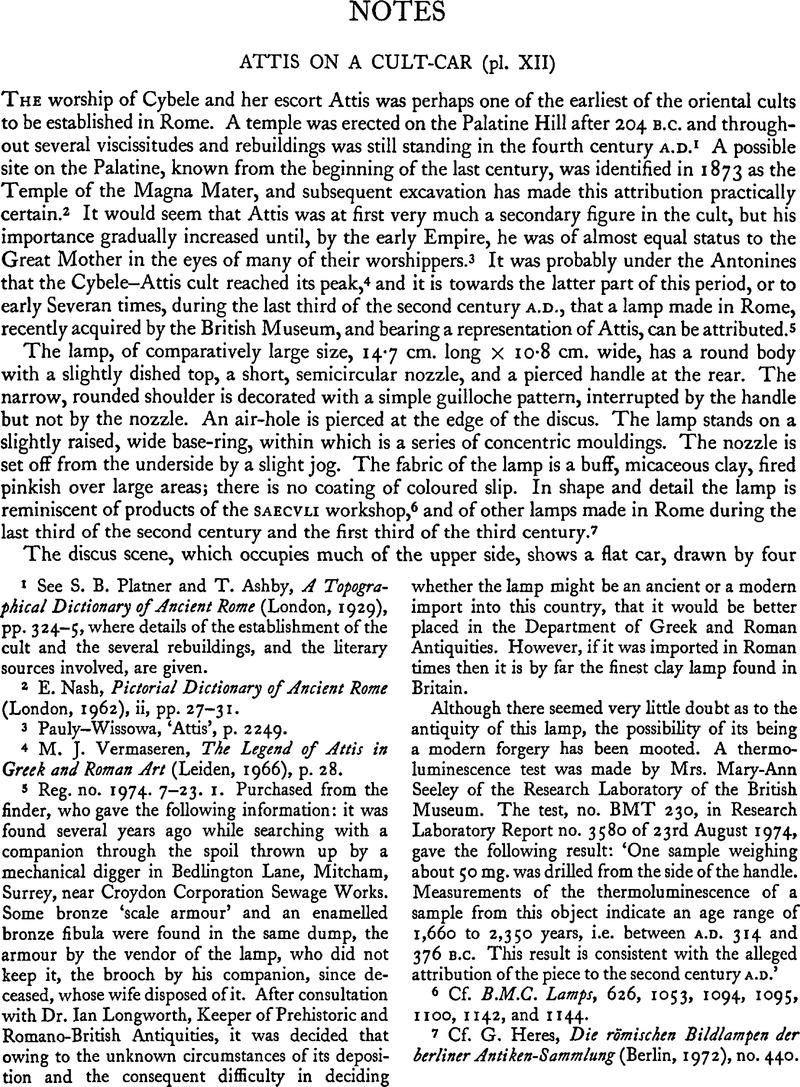No CrossRef data available.

page 72 note 1 See Platner, S. B. and Ashby, T., A Topographical Dictionary of Ancient Rome (London, 1929), pp. 324–5Google Scholar, where details of the establishment of the cult and the several rebuildings, and the literary sources involved, are given.
page 72 note 2 Nash, E., Pictorial Dictionary of Ancient Rome (London, 1962), ii, pp. 27–31Google Scholar.
page 72 note 3 Pauly-Wissowa, ‘Attis’, p. 2249.
page 72 note 4 Vermaseren, M. J., The Legend of Attis in Greek and Roman Art (Leiden, 1966), p. 28Google Scholar.
page 72 note 5 Reg. no. 1974. 7–23. 1. Purchased from the finder, who gave the following information: it was found several years ago while searching with a companion through the spoil thrown up by a mechanical digger in Bedlington Lane, Mitcham, Surrey, near Croydon Corporation Sewage Works. Some bronze ‘scale armour’ and an enamelled bronze fibula were found in the same dump, the armour by the vendor of the lamp, who did not keep it, the brooch by his companion, since deceased, whose wife disposed of it. After consultation with Dr. Ian Longworth, Keeper of Prehistoric and Romano-British Antiquities, it was decided that owing to the unknown circumstances of its deposition and the consequent difficulty in deciding whether the lamp might be an ancient or a modern import into this country, that it would be better placed in the Department of Greek and Roman Antiquities. However, if it was imported in Roman times then it is by far the finest clay lamp found in Britain.
Although there seemed very little doubt as to the antiquity of this lamp, the possibility of its being a modern forgery has been mooted. A thermoluminescence test was made by Mrs. Mary-Ann Seeley of the Research Laboratory of the British Museum. The test, no. BMT 230, in Research Laboratory Report no. 3580 of 23rd August 1974, gave the following result: ‘One sample weighing about 50 mg. was drilled from the side of the handle. Measurements of the thermoluminescence of a sample from this object indicate an age range of 1,660 to 2,350 years, i.e. between A.D. 314 and 376 B.C. This result is consistent with the alleged attribution of the piece to the second century A.D.’
page 72 note 6 Cf. B.M.C. Lamps, 626, 1053, 1094, 1095, 1100, 1142, and 1144.
page 72 note 7 Cf. Heres, G., Die römischen Bildlampen der berliner Antiken-Sammlung (Berlin, 1972), no. 440Google Scholar.
page 73 note 1 Compare the throne of Fecunditas on a coin of Julia Domna: B.M.C. Roman Coins, v, pl. xxi, 4.
page 73 note 2 Annali dell’ Institute di Correspondenza Archeologica, xli (1869), 239Google Scholar.
page 73 note 3 M. J. Vermaseren, op. cit., p. 8, note 2.
page 73 note 4 JdI 1 AA (1935), pp. 521–4; A. Levi, La Patera d’Argento di Parabiago (Rome, 1935). An Antonine date, or slightly later, seems probable for this dish, but Donald Strong, in his Greek and Roman Gold and Silver Plate (London, 1966), p. 198Google Scholar, prefers a much later date, in the fourth or early fifth century A.D.
page 73 note 5 Richter, G. M. A., Greek, Etruscan and Roman Bronzes (New York, 1915Google Scholar), no. 258.
page 73 note 6 A. Levi, op. cit., p. 8, fig.2b.
page 73 note 7 B.M.C. Roman Coins, iv, pl. xxxvi, 1.
page 73 note 8 Ibid., v, pls. xxviii, 3–4, and XLVII, 9.
page 73 note 9 Rams are shown drawing cars of a different form: compare, for example, a child’s sarcophagus in the Louvre, in Himmelmann, N., Typologische untersuchungen an römischen Sarkophagreliefs des 3. und 4. Jahrhunderts n. Chr. (Mainz, 1973Google Scholar), pl. xliia.